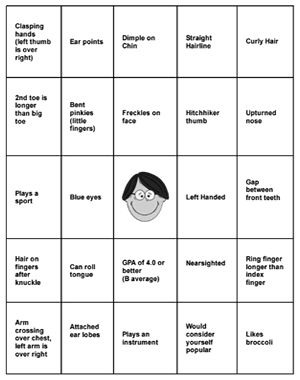
This activity is a good starter for genetics units. Students are often fascinated by traits that are visible. Lively discussions of human genetics will often include students asking tons of questions about what they view as “oddities.”
Though, many of those traits would be difficult to establish as strictly genetics, it provides a good starting point for learning what traits follow basic Mendelian patterns. In fact, most of the examples of straight up Mendelian patterns of dominance and recessiveness are myths.
You may even be shocked to learn some of the examples you are using in class are not controlled by one set of alleles and are not examples of Mendelian genetics. Here is a great resource for determining which examples are myths: “Myths of Human Genetics.“
As you flip through a powerpoint describing some of these traits, students check them off on a bingo-style grid if they (or anyone in their group) displays the trait. Follow up with a discussion on traits that are inherited, like Darwin ear points, versus traits that are likely environmental or learned, like playing sports.
Grade Level: 6-9 | Time Required: 30-45 minutes

HS-LS3-1 Ask questions to clarify relationships about the role of DNA and chromosomes in coding the instructions for characteristic traits passed from parents to offspring

